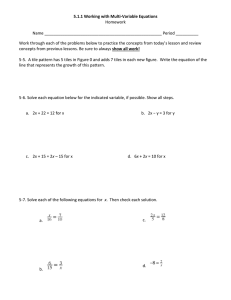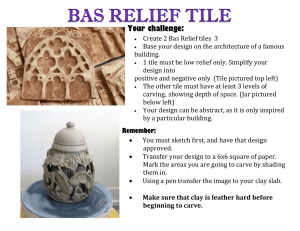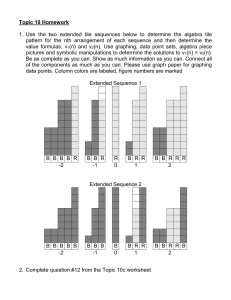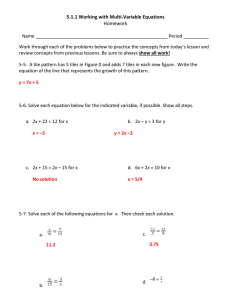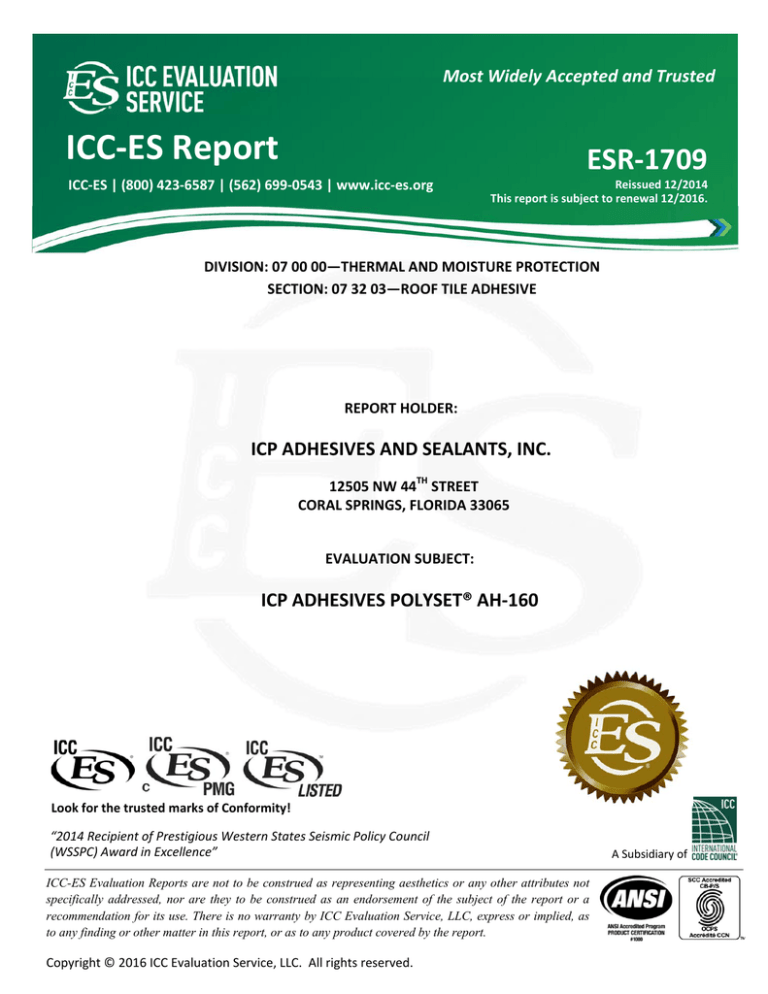
Most Widely Accepted and Trusted 0 ICC‐ES Report ESR‐1709
ICC‐ES | (800) 423‐6587 | (562) 699‐0543 | www.icc‐es.org
000 Reissued 12/2014
This report is subject to renewal 12/2016.
DIVISION: 07 00 00—THERMAL AND MOISTURE PROTECTION SECTION: 07 32 03—ROOF TILE ADHESIVE REPORT HOLDER: ICP ADHESIVES AND SEALANTS, INC. TH
12505 NW 44
STREET CORAL SPRINGS, FLORIDA 33065 EVALUATION SUBJECT: ICP ADHESIVES POLYSET® AH‐160 Look for the trusted marks of Conformity! “2014 Recipient of Prestigious Western States Seismic Policy Council (WSSPC) Award in Excellence” ICC-ES Evaluation Reports are not to be construed as representing aesthetics or any other attributes not
specifically addressed, nor are they to be construed as an endorsement of the subject of the report or a
recommendation for its use. There is no warranty by ICC Evaluation Service, LLC, express or implied, as
to any finding or other matter in this report, or as to any product covered by the report.
Copyright © 2016 ICC Evaluation Service, LLC. All rights reserved.
A Subsidiary of ICC-ES Evaluation Report
ESR-1709
Reissued December 2014
Revised April 2016
This report is subject to renewal December 2016.
www.icc-es.org | (800) 423-6587 | (562) 699-0543
DIVISION: 07 00 00—THERMAL AND MOISTURE
PROTECTION
Section: 07 32 03—Roof Tile Adhesive
REPORT HOLDER:
ICP ADHESIVES AND SEALANTS, INC.
TH
12505 NW 44 STREET
CORAL SPRINGS, FLORIDA 33065
(954) 344-3566
www.icpadhesives.com
EVALUATION SUBJECT:
ICP ADHESIVES POLYSET® AH-160
1.0 EVALUATION SCOPE
Compliance with the following codes:
2012, 2009 and 2006 International Building Code® (IBC)
A Subsidiary of the International Code Council ®
an area where the temperature is kept between 45° and
95°F (7.2° and 35°C). The product temperature prior to
application should be between 70°F and 90°F (21.1° and
32.2°C). The minimum ambient temperature is 45°F
(7.2°C) and surface temperature must be 55°F (12.8°C)
and rising.
The components are also available in disposable
cylinders called AH-160 PROPACK® in 26.5-pound
®
(11.9 kg) (AH-160 PROPACK 30’s) or 85.7-pound
®
(38.6 kg) (AH-160 PROPACK 100’s) cylinders when the
®
AH-160 PROPACK dispensing system is used. Once the
cylinder valves are opened, the chemicals must be used
within 30 days. AH-160 PROPACK® kits must be stored
in an area where the temperature of the chemical is
kept between 45° and 95°F (7.2° and 35°C). The product
temperature prior to application should be between 70°F
and 90°F (21.1° and 32.2°C). The minimum ambient
temperature is 45°F (7.2°C) and surface temperature must
be 55°F (12.8°C) and rising.
Properties evaluated:
The foam plastic adhesive, when applied in such a
fashion as to be representative of actual installation
conditions, has a flame-spread rating of 75 or less when
tested in accordance with ASTM E84.
Physical properties
3.2 Roof Deck:
Wind resistance
Roof decks must be plywood bonded with exterior glue or
OSB having a 32/16 span rating, and must comply with U.S.
DOC PS-1 or PS-2, respectively. Minimum sheathing
thicknesses are specified in Tables 1, 2 and 3.
2012, 2009 and 2006 International Residential Code®
(IRC)
Roof classification
2.0 USES
ICP Adhesives Polyset® AH-160 is an expanding adhesive
used to adhere clay and concrete roof tiles to
underlayments installed over solid sheathing. ICP
®
Adhesives Polyset AH-160 is used to attach hip and ridge
tiles and can be used to seal the junction between hip and
ridge frames and field tiles.
3.0 DESCRIPTION
Materials:
3.1 ICP Adhesives Polyset® AH-160:
®
ICP Adhesives Polyset AH-160 is a two-component
expanding polyurethane foam plastic that is mixed and
dispensed from a dispensing system provided by ICP
Adhesives and Sealants, Inc. The components are
available in refillable tanks ranging in size from 17 to
350 gallons (64.3 to 1325 L). The materials have a shelf
life of 12 months when stored in unopened containers.
Once the tank valves are opened, the chemicals must be
used within 90 days. Refillable cylinders must be stored in
3.3 Underlayment:
Underlayment must be as described in Table 1, 2 or 3 and
Section 4.1.2 and 4.2.1 of this report, and must comply
with the applicable code.
3.4 Hip and Ridge Channels:
Hip and ridge channels, when used, are East Coast
Metals, Inc. Trim Lock or Trim Lock Plus pre-formed metal
channels. They are formed from ASTM B209, 3003-H14
aluminum alloy with a minimum thickness of 0.030 inch
(0.8 mm), ASTM A653 G90 galvanized steel with a
minimum thickness of 0.019 inch (0.5 mm) or ASTM A792
AZ50 galvalume steel with a minimum thickness of
0.019 inch (0.5 mm). They are available in heights of 3,
3.5, 4, 5 or 6 inches (76, 89, 102, 127 or 152 mm) and
have 1.5 inch (38 mm) deck-flanges. See Figure 5.
3.5 Roof Tile:
Roof tiles must be regular-weight or lightweight clay or
concrete tiles, and must be recognized in a current ICC-ES
ICC-ES Evaluation Reports are not to be construed as representing aesthetics or any other attributes not specifically addressed, nor are they to be construed
as an endorsement of the subject of the report or a recommendation for its use. There is no warranty by ICC Evaluation Service, LLC, express or implied, as
to any finding or other matter in this report, or as to any product covered by the report.
1000
Copyright © 2016 ICC Evaluation Service, LLC. All rights reserved.
Page 1 of 11
ESR-1709 | Most Widely Accepted and Trusted
evaluation report that specifically recognizes use of roof tile
adhesive. Regardless of shape, tiles must conform to the
requirements specified in items 4, 5, 6 and 7 of IBC
Section 1609.5.3 Tiles may also be conventional barrelshaped tiles having a minimum rise-to-width ratio of 1:4.
The tiles must have a maximum tile factor of 1.407 ft3. The
tile factor is defined as TF = 0.76 L2b, where L is the tile
length in feet and b is the tile width in feet (for SI: TF =
12 454 L2b, where L and b are in mm). For purposes of
this report, flat- and low-profile tiles have a rise equal to or
1
less than /2 inch (12.7 mm), and a rise-to-width ratio of
less than or equal to 1:5; medium-profile tiles have a rise
greater than 1/2 inch (12.7 mm) and a rise-to-width ratio
less than or equal to 1:5; high-profile tiles have a rise to
width ratio greater than 1:5.
4.0 DESIGN AND INSTALLATION:
4.1 Design:
4.1.1 Wind Resistance: Allowable wind resistance for
underlayment fastening patterns and various methods of
roof tile adhesive application are noted in Tables 1 through
4 and Figures 1 through 3 of this report.
4.1.2 Underlayment: The required design pressure for
the building is the component and cladding wind load
determined in accordance with Section 1609 of the IBC.
The fastener spacing for the selected underlayment
(single-ply, single-ply with battens, or two-ply) is then
determined from Table 1, 2 or 3, of this report as
applicable. Two-ply system is considered in this application
as an anchor sheet mechanically attached to the substrate
and a cap sheet adhered to the anchor sheet with hotor cold-applied asphaltic adhesive. The allowable uplift
resistance determined from Table 1, 2 or 3 must be equal
to or greater than the required design pressure determined
in accordance with Section 1609.5.3 of IBC.
4.1.3 Tile: The required aerodynamic uplift moment, Ma,
for the tiles must be determined from Equation 16-34 in
2012 IBC Section 1609.5.3, Equation 16-33 in 2009 IBC
Section 1609.5.3, or Equation 16-35 in 2006 IBC Section
1609.5.3. The allowable aerodynamic uplift moment for
each type of adhesive application (two paddy, medium
paddy or large paddy) is indicated in Table 4A or Table 4B
of this report. The allowable uplift moment determined from
Table 4A or Table 4B must be equal to or greater than the
required aerodynamic uplift moment.
4.2 Installation:
4.2.1 Underlayment: Underlayment installation must be
as described in Section 4.2.1.1 or 4.2.1.2.
4.2.1.1 Single-ply
Underlayment:
Single-ply
underlayments are limited to roof slopes between 4:12 and
6:12 (18° and 26°). The underlayment consists of a single
layer of 90-pound, mineral-surfaced roll roofing complying
with ASTM D6380. The underlayment is applied
horizontally along the roof line and is mechanically
fastened to the roof deck with 0.120 inch (3 mm [No. 11
gage]), ring shank, corrosion-resistant roofing nails with
15/8-inch-diameter (41.3 mm) tin caps, spaced in
accordance with the fastening requirements of Table 1 or
Table 2. Nails must be of sufficient length to penetrate the
3
deck a minimum of /4 inch (19.1 mm) or through the
thickness of the sheathing, whichever is less. The
underlayment must be installed with a weave pattern at all
valleys. The underlayment must extend 4 inches (102 mm)
up vertical surfaces.
4.2.1.2 Hot Mop 30/90 (Two-Ply) Underlayment
System: The 30/90 underlayment may be used on all roof
slopes between 21/2:12 and 12:12 (12° and 45°). A base
Page 2 of 11
ply consisting of ASTM D226, Type II, asphalt-saturated
felt is applied over the roof deck with 2-inch (51 mm) head
laps and 6-inch (152 mm) end laps, and is attached to the
deck using 0.120 inch (3 mm [No. 11 gage]), ring shank,
5
corrosion-resistant roofing nails and 1 /8-inch-diameter
(41.3) tin caps spaced in accordance with the fastening
requirements in Table 3 of this report. Nails must be of
sufficient length to penetrate the deck a minimum of
3
/4 inch (19.1 mm) or through the thickness of the
sheathing, whichever is less. The underlayment must be
installed with a weave pattern at all valleys. The base ply
must extend 4 inches (102 mm) up vertical surfaces.
The top ply consists of one layer of 90-pound, mineralsurfaced, asphalt roll roofing complying with ASTM D6380.
The top ply is applied over the base ply with a full
mopping of ASTM D312, Type III or IV, asphalt applied at
a minimum rate of 25 pounds per 100 square feet
(1.21 kg/m2). Headlaps and endlaps in the top ply must be
a minimum of 3 inches (76 mm) and 6 inches (152 mm),
respectively. The top ply must be back-nailed using
corrosion-resistant roofing nails and tin caps as described
for the base ply, located a minimum of 1 inch (25.4 mm)
from the top edge of the sheet and spaced a maximum of
12 inches (305 mm) on center.
4.2.2 Flashing: Flashing must be installed in accordance
with IBC Sections 1503.2 and 1507.3.9, or IRC Sections
R903.2 and R905.3.8, as applicable.
4.2.3 Battens: When used, battens must be minimum
1-by-2 pressure-treated wood. The battens must be
fastened to the sheathing with three 8d [0.120-inchdiameter (3 mm)] corrosion-resistant ring shank nails for
each 4-foot-long (1219 mm) batten. A 1/2-inch (12.7 mm)
space must be left between the 4-foot-long (1219 mm)
battens.
4.2.4 Adhesive Application: Adhesive must be installed
in accordance with ICP Adhesives and Sealants, Inc.’s
published installation instructions. The tile and roof
underlayment must be clean and dry at the time of
application. The quantity and location of adhesive
application must be as determined from Table 4A, Table
4B and Figures 1 through 4B, as applicable. The maximum
adhesive-to-tile contact area must not exceed 33 percent
of the area of the tile. The adhesive must not be installed
under the head lug of the tile or into the side interlock
between tiles. The tile must be applied between
1 and 2 minutes after the adhesive has been dispensed.
The tiles may be adjusted during that period, provided the
tile is not lifted free and clear of the adhesive. If it is
necessary to lift the tile free and clear of the adhesive, the
adhesive must be reapplied.
Nailing of roof tiles is required as follows:
For roof slopes above 6:12 (27°), the eave course must
be fastened with one code-complying nail per tile, in
addition to the adhesive.
For roof slopes above 6:12 (27°), up to and including
7:12 (30°), every third tile in every fifth course must be
fastened with one code-complying nail, in addition to the
adhesive.
For roof slopes above 7:12 (30°), every tile must be
nailed in addition to having the adhesive, except for tiles
with batten lugs installed over battens. When using
battens, tile headlap must be 3 inches (76 mm) unless the
roof tile is recognized for other headlaps in the ICC-ES
evaluation report on the tile, and preformed flashing with
metal edge returns must be used.
ESR-1709 | Most Widely Accepted and Trusted
Nails must be as specified in the applicable code for roof
tile attachment. Plastic cement must be applied to seal all
nail penetrations of the underlayment, except when use is
made of battens and preformed flashing with metal edge
returns.
4.2.5 Hips and Ridges:
4.2.5.1 Hip and Ridge Nailer Board: The nailer board
must be of nominal 2-by wood of sufficient height to
accommodate the tile profile. The nailer board must be
attached to roof framing spaced a maximum of 24 inches
3
(610 mm) on center, using minimum /4-inch-wide
(19.1 mm), No. 22 gage, galvanized steel straps or
brackets. Each end of the strap or bracket must be
fastened to the framing with one corrosion-resistant 10d
common or box nail or a No. 8 wood screw, of sufficient
1
length to penetrate the framing a minimum of 1 /2 inches
3
(38 mm) for nails and /4 inch (19.1 mm) for screws.
Prior to the installation of the hip and ridge tiles, the
junction between the wood nailer board and the field tile
may be sealed by application of a bead of ICP Adhesives
®
Polyset AH-160 on both sides of the nailer board. The hip
and ridge tiles must be attached to the nailer board with a
3
/4-inch-thick (19.1 mm), 2-inch-wide (51 mm) bead of
adhesive along the full length of the tile excluding 2 inches
2
(51 mm) of the eave-end of the tile, ensuring 30-35 in
2
(193.5-225.8 cm ) of adhesive coverage on the underside
of the tile (See Figure 4A) or with one #10 x 2 ½" screw
used to secure the head of tile and a 1x6" bead of
adhesive at the overlap. (See Figure 4B).
4.2.5.2 Metal Hip and Ridge Frame: Metal frames for
hips and ridges must be minimum No. 26 gage,
galvanized, preformed steel having a 23/8-inch (60.3 mm)
1
to 4-inch-wide (102 mm) top with a /2-inch (12.7) dip in the
center of sufficient height to accommodate the tile profile.
The metal frame must be attached to minimum 15/32-inchthick (11.9 mm) roof deck using 11/4-inch-long (31.8 mm),
0.120-inch-diameter (3 mm [No. 11 gage]), hot-dipped
galvanized ring-shank or smooth roofing nails spaced at
6 inches (152 mm) on center on each side of the ridge
or hip.
Before installation of the hip and ridge tiles, the junction
between the metal frame and the field tile may be sealed
®
by application of a bead of ICP Adhesives Polyset
AH-160 on both sides of the support member. The hip and
ridge tiles must be attached to the metal frame with a
3
/4-inch-thick (19.1 mm), 2-inch-wide (51 mm) bead of
adhesive along the full length of the tile excluding 2 inches
(51 mm) on the eave-end of the tile, ensuring 30-35 in2
2
(193.5-225.8 cm ) of adhesive coverage on the underside
of the tile (See Figure 4A).
4.2.5.3 Hip and Ridge Channels:
4.2.5.3.1 Trim Lock: Trim Lock must be attached using
minimum 0.120-inch-diameter (No. 11 gage) x 11/4 inch
long x 3/8 inch head diameter (3 mm x 32 mm x 10 mm)
galvanized annular ring shank nails spaced 6 inches on
Page 3 of 11
center along both deck-flanges. Fasteners must be
positioned 3/4 inch (19 mm) from the outside edge of each
deck-flange, and set in a bed of plastic roof cement.
4.2.5.3.2 Trim Lock Plus: Trim Lock Plus is attached to
the underlayment with a continuous 2 inch (51 mm) wide
®
bead of ICP Adhesives Polyset AH-160 on each flange.
4.2.5.4 Roof Classification: When concrete and clay
tiles recognized in an ICC-ES evaluation report are
adhered in accordance with this report using ICP
®
Adhesives Polyset AH-160, the roofing systems must
maintain their respective roof fire classifications provided
the tiles conform to Section 3.5 of this report.
5.0 CONDITIONS OF USE:
®
The ICP Adhesives Polyset AH-160 described in this
report comply with, or are suitable alternatives to what is
specified in, those codes listed in Section 1.0 of this report,
subject to the following conditions:
5.1 The product must be installed in accordance with
this report, the manufacturer's instructions and the
applicable code. In the event of a conflict between the
manufacturer's instructions and this report, this report
governs.
5.2 Adhesive application of tiles is limited to conventional
code-prescribed concrete and clay roofing tiles
conforming to Section 3.5 of this report. The concrete
and clay roofing tiles must be recognized in a current
ICC-ES evaluation report permitting adhesive
application.
5.3 Adhesive application must be in accordance with
Section 4.2.4 of this report.
5.4 Installation of roof tiles with the adhesive system is
restricted to areas in which the mean rainfall does not
exceed 20 inches (508 mm) and the average of the
daily lows for any month is at least 30°F (-1.1°C).
5.5 ICP Adhesives Polyset® AH-160 is manufactured in
Tomball, TX, under a quality-control program with
inspections provided by ICC-ES.
6.0 EVIDENCE SUBMITTED
Data and reports of tests in accordance with the ICC-ES
Acceptance Criteria for Adhesive Attachment of Concrete
or Clay Roofing Tiles (AC152), dated June 2014.
7.0 IDENTIFICATION
Containers of ICP Adhesives Polyset® AH-160 are labeled
with the ICP Adhesives and Sealants, Inc., name and
address, the product name, the batch number, and the
evaluation report number ESR-1709. "A" components are
identified with a red label; "B" components are identified
with a blue label.
ESR-1709 | Most Widely Accepted and Trusted
Page 4 of 11
TABLE 1—ALLOWABLE UPLIFT RESISTANCE FOR THE SINGLE-PLY UNDERLAYMENT SYSTEM
SINGLE-PLY UNDERLAYMENT FASTENING SYSTEM – (ONE ROW IN FIELD)(DIRECT TO DECK)
Allowable Uplift Resistance (psf)
Field
Lap
15
Backnail
Cap
/32"
1
Attachment
(inches
(inches
Sheet
o/c)
o/c)
Smooth
Deformed2 Smooth
(inches o/c)
12
6
N/A
23.8
27.1
30.2
One row in the field, one row at the lap.
9
6
N/A
26.5
30.1
33.5
6
6
N/A
31.8
36.1
40.2
(Direct to Deck)
3
6
N/A
47.6
54.2
60.4
SINGLE-PLY UNDERLAYMENT FASTENING SYSTEM – (TWO ROWS IN FIELD)(DIRECT TO DECK)
Allowable Uplift Resistance (psf)
Field
Lap
15
Backnail Cap
/32"
Attachment1
(inches
(inches
Sheet
o/c)
o/c)
Smooth Deformed2 Smooth
(inches o/c)
12
6
N/A
33.8
38.4
42.8
Two rows staggered in field, one row at the lap.
9
6
N/A
39.0
44.4
49.5
6
6
N/A
49.6
56.5
62.9
(Direct to Deck)
3
6
N/A
81.4
92.6
103.1
SINGLE-PLY UNDERLAYMENT FASTENING SYSTEM – (THREE ROWS IN FIELD)(DIRECT TO DECK)
Allowable Uplift Resistance (psf)
Field
Lap
15
Backnail
Cap
/32"
1
Attachment
(inches
(inches
Sheet
o/c)
o/c)
Smooth Deformed2 Smooth
(inches o/c)
12
6
N/A
41.7
47.4
52.8
Three rows staggered in the field, on row at the
9
6
N/A
49.6
56.5
62.9
lap.
6
6
N/A
65.5
74.5
83.0
(Direct to Deck)
3
6
N/A
113.2
128.8
143.3
19
/32"
Deformed2
34.3
38.1
45.7
68.6
19
/32"
Deformed2
48.6
56.2
71.5
117.2
19
/32"
Deformed2
60.0
71.5
94.3
163.0
For SI: 1 inch = 25.4 mm, 1 psf = 0.0479 kPa.
1
See Section 4.2.1 for fasteners.
2
Deformed shank is inclusive of either a ring or screw shank nail.
TABLE 2—ALLOWABLE UPLIFT RESISTANCE FOR THE SINGLE-PLY UNDERLAYMENT WITH BATTENS SYSTEM
SINGLE-PLY WITH BATTENS UNDERLAYMENT FASTENING SYSTEM – (ONE ROW IN FIELD)
Allowable Uplift Resistance (psf)
Field
Lap
15
Backnail
Cap
/32"
1
Attachment
(inches
(inches
Sheet
o/c)
o/c)
Smooth
Deformed2 Smooth
(inches o/c)
12
6
N/A
40.3
43.6
51.0
9
6
N/A
42.9
46.6
54.4
One row in the field, one row at the lap, and battens3
14" o/c.
6
6
N/A
48.2
52.6
61.1
3
6
N/A
64.1
70.7
81.2
SINGLE-PLY WITH BATTENS UNDERLAYMENT FASTENING SYSTEM – (TWO ROWS IN FIELD)
Allowable Uplift Resistance (psf)
Field
Lap
15
Backnail
Cap
/32"
1
Attachment
(inches
(inches
Sheet
o/c)
o/c)
Smooth
Deformed2 Smooth
(inches o/c)
12
6
N/A
50.2
54.9
63.6
9
6
N/A
55.5
60.9
70.3
Two rows staggered in the field, one row at the lap,
and battens2 14" o/c.
6
6
N/A
66.1
72.9
83.7
3
6
N/A
97.8
109.7
123.9
SINGLE-PLY WITH BATTENS UNDERLAYMENT FASTENING SYSTEM – (THREE ROWS IN FIELD)
Allowable Uplift Resistance (psf)
Field
Lap
15
Backnail Cap
/32"
Attachment1
(inches
(inches
Sheet
o/c)
o/c)
Smooth Deformed2 Smooth
(inches o/c)
12
6
N/A
58.2
63.9
73.6
9
6
N/A
66.1
72.9
83.7
Three rows staggered in the field, one row at the lap,
and battens3 14" o/c.
6
6
N/A
82.0
91.0
103.8
3
6
N/A
129.6
145.2
164.2
For SI: 1 inch = 25.4 mm, 1 psf = 0.0479 kPa.
1
See Section 4.2.1 for fasteners.
2
Deformed shank is inclusive of either a ring or screw shank nail.
3
Batten density was based on 3 – 8d – 0.120 -inch diameter ring shank nails per 4 foot batten, spaced 14 inches o.c.
19
/32"
Deformed2
55.1
59.0
66.6
89.4
19
/32"
Deformed2
69.4
77.0
92.3
138.0
19
/32"
Deformed2
80.9
92.3
115.2
183.8
ESR-1709 | Most Widely Accepted and Trusted
Page 5 of 11
TABLE 3—ALLOWABLE UPLIFT RESISTANCE FOR THE TWO-PLY UNDERLAYMENT SYSTEM
TWO-PLY UNDERLAYMENT FASTENING SYSTEM - (TWO ROWS IN FIELD)
Allowable Uplift Resistance (psf)
Field
Attachment
1
Lap
(inches o/c)
15
Backnail Cap Sheet
(inches o/c)
(inches o/c)
19
/32"
Smooth
/32"
Deformed
2
Smooth
Deformed
Two rows staggered in
12
6
12
41.6
47.4
52.7
60.0
the field, one row at the lap
9
6
12
47.0
53.5
59.5
67.7
and one row at the top
6
6
12
57.6
65.5
72.9
82.9
of the cap sheet edge.
3
6
12
89.3
101.6
113.2
128.6
2
TWO-PLY UNDERLAYMENT FASTENING SYSTEM - (THREE ROWS IN FIELD)
Allowable Uplift Resistance (psf)
Field
Attachment
1
Lap
(inches o/c)
15
Backnail Cap Sheet
(inches o/c)
(inches o/c)
19
/32"
Smooth
/32"
Deformed
2
Smooth
Deformed
Three rows staggered in
12
6
12
49.6
56.5
62.9
71.5
the field, one row at the lap
9
6
12
57.6
65.5
72.9
82.9
and one row at the top
6
6
12
73.5
83.6
93.0
105.8
of the cap sheet edge.
3
6
12
121.1
137.8
153.4
174.4
2
TWO-PLY UNDERLAYMENT FASTENING SYSTEM - (FOUR ROWS IN FIELD)
Allowable Uplift Resistance (psf)
Field
Attachment
1
Lap
(inches o/c)
15
Backnail Cap Sheet
(inches o/c)
(inches o/c)
19
/32"
Smooth
/32"
Deformed
2
Smooth
Deformed
Four rows staggered in
12
6
12
58.6
66.6
74.2
84.3
the field, one row at the lap
9
6
12
69.2
78.7
87.6
99.6
and one row at the top
6
6
12
90.3
102.8
114.4
130.1
of the cap sheet edge.
3
6
12
153.9
175.1
194.9
221.6
2
For SI: 1 inch = 25.4 mm. 1 psf = 0.0479kPa.
1
See Section 4.2.1 for fasteners.
Deformed shank is inclusive of either a ring or screw shank nail.
2
TABLE 4A—ALLOWABLE AERODYNAMIC UPLIFT MOMENT VALUES ─ FIELD TILE
PROFILE
1
High
Medium
Low/Flat
MATERIAL
Clay
Concrete
Concrete or Clay
Concrete or Clay
Concrete or Clay
Concrete or Clay
Concrete or Clay
Concrete or Clay
Concrete or Clay
Concrete or Clay
Clay
2-Piece Barrel
Concrete
PADDY
2,3
Single Paddy (Independent) / Large (10"x2") (~45 gram)
Single Paddy (Independent) / Large (10"x2") (~63 gram)
Single Paddy (Independent) / Medium (7"x2") (~30 gram)
Two Paddy (Interdependent) (4"x4" & 2"x4") (~12 gram per paddy)
Single Paddy (Independent) / Large (10"x2") (~54 gram)
Single Paddy (Independent) / Medium (7"x2") (~30 gram)
Two Paddy (Interdependent) (4"x4" & 2"x4") (~12 gram per paddy)
Single Paddy (Independent) / Large (10"x2") (~45 gram)
Single Paddy (Independent) / Medium (7"x2") (~30 gram)
Two Paddy (Interdependent) (4"x4" & 2"x4") (~12 gram per paddy)
2x10-inch (~35 gram) for pans;
2 @ 1x10-inch ( ~17 gram) for cap
2x10-inch (~35 gram) for pans;
2 @ 1x10-inch ( ~17 gram) for cap
ALLOWABLE
AERODYNAMIC UPLIFT
4
MOMENT (ft-lb)
129
102
57
32
61
33
52
104
52
46
143
101
For SI: 1 inch = 25.4 mm 1 psf = 0.0479 kPa.
1
See Section 3.5 for definition of tile profiles.
2
See Figures 1 through 3 for typical installation details (approximate size and placement) of the paddy.
3
Select a paddy size and placement with an allowable uplift moment equal to or greater than the required aerodynamic uplift moment as
determined in accordance with Section 4.1.3 of this report.
4
The tabulated allowable aerodynamic uplift moment is for the fixing (adhesive) only.
ESR-1709 | Most Widely Accepted and Trusted
Page 6 of 11
TABLE 4B—ALLOWABLE UPLIFT FORCE – HIP/RIDGE TILES
HIP/RIDGE
TILE MATERIAL
Clay
Concrete
SUBSTRATE
2x wood stringer/ridge board
2x wood stringer/ridge board
™
Concrete or Clay
PADDY
Trim Lock
(Aluminum, Galvanized, Galvalume)
™
Trim Lock Plus
(Aluminum, Galvanized, Galvalume)
1,2
2" Bead Length of Tile less 2 inches
(Independent Paddy) (~34 gram/ft)
Interdependent Paddy (~10.5 gram) with
1
#10 x 2 /2" screw at head of tile and a
1x6" bead of adhesive at the overlap
2" Bead Length of Tile less 2 inches
(Independent Paddy) (~34 gram/ft)
Interdependent Paddy (~10.5 gram) with
1
#10 x 2 /2" screw at head of tile and a
1x6" bead of adhesive at the overlap
ALLOWABLE UPLIFT
3
FORCE (lb)
111
85
102
65
1
1 /2" Bead Length of Tile less 2 inches
(~34 gram/ft)
160
1
1 /2" Bead Length of Tile less 2 inches
(~34 gram/ft)
155
For SI: 1 inch = 25.4 mm 1 psf = 0.0479 kPa.
1
See Figures 1 through 4 for typical installation details (approximate size and placement) of the paddy.
2
Select a paddy size and placement with an allowable uplift moment equal to or greater than the required aerodynamic uplift moment as
determined in accordance with Section 4.1.3 of this report.
3
The tabulated allowable uplift force is for the fixing (adhesive) only.
FIGURE 1—TWO PADDY PLACEMENT
ESR-1709 | Most Widely Accepted and Trusted
FIGURE 2—MEDIUM PADDY PLACEMENT
Page 7 of 11
ESR-1709 | Most Widely Accepted and Trusted
Page 8 of 11
Two Piece Barrel – High Profile Tile
FIGURE 3—LARGE PADDY PLACEMENT
ESR-1709 | Most Widely Accepted and Trusted
FIGURE 4A—INDEPENDENT APPLICATION - HIP AND RIDGE
Page 9 of 11
ESR-1709 | Most Widely Accepted and Trusted
Page 10 of 11
FIGURE 4B—INTERDEPENDANT APPLICATION – HIP AND RIDGE
TRIM LOCK
TRIM LOCK PLUS
FIGURE 5—TRIM LOCK AND TRIM LOCK PLUS
ESR-1709 | Most Widely Accepted and Trusted
Page 11 of 11
Installation Verification Card
Date:
Permit Number:
Project Name or Owner:
Phone Number:
Project Address:
Tile Manufacturer and Tile Profile :
Required Aerodynamic Uplift Moment (ft.lbs):
Paddy Placement to be used:
Allowable Uplift Moment (ft.lbs):
(See ICC-ES ESR-1709 Section 4.1.3 for required aerodynamic uplift moment, Tables 4A and 4B for allowable uplift moment for each tile
type and paddy size and Figures 1, 2 or 3 for paddy placement)
Note: Installer must check a minimum of 1 tile per square for the following paddy placement, contact area, and cured adhesive paddy properties:
Underside of tile
Two Paddy Placement
Contact Area:
Min. 8-9 sq. in.
Flat/Low Profile Tile: Verify 4" X 4" x 1" paddy is applied just below second course line under the strengthening rib closest to the underlock
side strengthening rib. * Apply a second 2" x 4" x 3/4" paddy on top of the course below the tile to be installed and position paddy on top of the
*Min. 9-11 sq. in.*
strengthening rib nearest the underlock side of that tile. Apply tile in staggered pattern.
Double Roll-Medium Profile Tile: Verify 4" X 4" x 1" paddy is applied just below course line under the pan portion of the tile, closest to the
Min. 8-9 sq. in.
underlock side of the tile to be installed. * Apply a second 2" x 4" x 3/4" paddy on top of the course below the tile to be installed and position
*Min. 9-11 sq. in.
paddy over the pan portion of tile, closest to overlock side of that tile. Apply tile in staggered pattern.
Min. 8-9 sq. in.
Single Pan-High Profile Tile: Verify 4" X 4" x 1" paddy is applied just below second course line under the strengthening rib closest to the
underlock side of the second course tile to be installed. * Apply a second 2" x 4" x 3/4" paddy on top of the course below the tile to be installed
*Min. 9-11 sq.in.
and position paddy over the pan portion of the tile, closest to the strengthening rib nearest the overlock side of that tile.
Eave Course - All Tile Profile: Verify 2"(w) x 10"(l) paddy is applied 3-4" from head of tile opposite the eave-end of the tile.
Min. 17-23 sq. in.
Medium Paddy Placement
Flat/Low Profile Tile: Verify 2"(w) x 7"(l) paddy is applied 2-3" from head of tile placed under the overlock side strengthening rib.
Double Roll - Medium Profile Tile: Verify 2"(w) x 7"(l) paddy is applied 2-3" from head of tile placed under the pan of the overlock side.
Single Pan - High Profile Tile: Verify 2"(w) x 7"(l) paddy is applied 2-3" from head of tile placed under the pan portion of the tile.
Eave Course - All Tile Profile: Verify 2"(w) x 10"(l) paddy is applied 3-4" from head of the tile opposite the eave-end of the tile.
Large Paddy Placement
Flat/Low Profile Tile: Verify 2"(w) x 10"(l) paddy is applied 3-4" from head of tile placed under the overlock side strengthening rib.
Double Roll-Medium Profile Tile: Verify 2"(w) x 10"(l) paddy is applied 3-4" from head of tile placed under the pan of the overlock side.
Single Pan - High Profile Tile: Verify2"(w) x 10"(l) paddy is applied 3-4" from head of tile placed under the pan portion of the tile.
Eave Course - All Tile Profile: Verify 2"(w) x 10"(l) paddy is applied 3-4" from head tile opposite the eave-end of the tile.
Underside of tile
Contact Area:
Min. 10-12 sq. in.
Min. 12-14 sq. in.
Min. 17-19 sq. in.
Min. 17-23 sq. in.
Underside of tile
Contact Area:
Min. 17-23 sq. in.
Min. 17-23 sq. in.
Min. 17-23 sq. in.
Min. 17-23 sq. in.
Pan Tiles: Verify 2"(w) x 10"(l) paddy is applied 3-4" from head of tile placed under the pan tile.
Cap Tiles: Verify 1"(w) x 10'(l) bead is applied 3-4" from the head of the tile placed 1" in from each longitudinal edge of the cover tile.
Underside of tile
Contact Area:
Min. 65-70 sq. in.
Min. 20-25 sq. in.
Hip and Ridge
Underside of tile
Contact Area:
Two-Piece Barrel (Cap and Pan Tile)
Hip or Ridge Tiles Apply 2" x7" paddy centered on underside of tile or apply continuous bead of adhesive onto ridge support member.
Hip or Ridge Tiles Interdependent Paddy with one #10 x 21/2" screw at head of tile and a 1" x 6" bead of adhesive at the overlap.
Min. 30--35 sq. in.
Min. 10-15 sq. in.
By my signature below, I verify I have checked a minimum of 1 tile per square of tile installed and the foam adhesive
paddies are not soft/spongy or brittle/crunchy, the adhesive paddy placement is correct, and the appropriate contact area
has been met for the applicable system:
Qualified Applicator Name (print), Signature and Date:
ICP Adhesives and Sealants, Inc. Qualified Applicator ID #:
FIGURE 6—INSTALLATION VERIFICATION CARD

